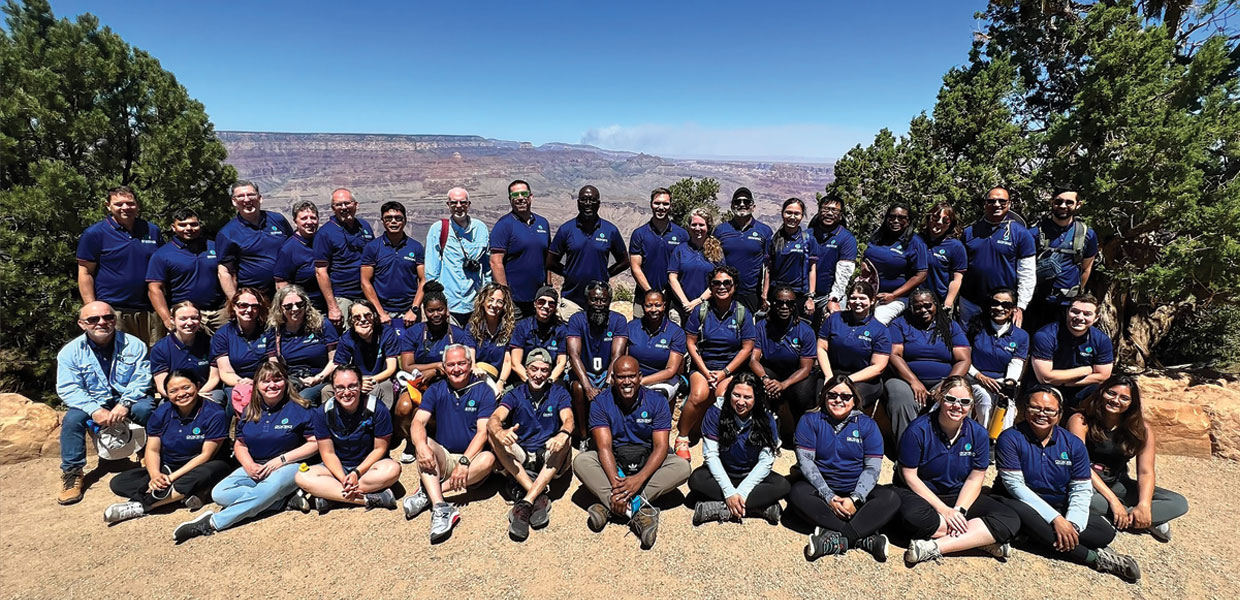

Just before the North American Division Educators’ Convention, August 7-10, 2023, in Phoenix, Arizona, a group of more than 40 passionate science teachers embarked on a journey to explore various geological landmarks.
The field trip, led by Geoscience Research Institute (GRI) scientists, offered participants a firsthand experience to enhance their appreciation and comprehension of geology and the history of the Earth, with the goal of enabling the teachers to integrate faith and science more effectively in their classrooms. They visited the Petrified Forest National Park, the Grand Canyon, Sunset Crater Volcano National Monument, and more.
At the Petrified Forest National Park, teachers observed the remains of trees that had turned to stone, revealing the wonders of natural transformation. Here they discussed the process of fossilization, how long it takes for wood to petrify, and how fossils paint a picture of past animal interactions and their environment. Walking among these fossilized tree logs provided an opportunity to discuss processes and sediment transport rates.
The trip through the breathtaking Grand Canyon offered a setting for discussions surrounding the origins debate and the geologic record. As the educators gazed into the vast chasm, they could not help but be humbled by the scale and complexity of the Earth’s geological history.
They were presented with the unique opportunity to study the intricate rock formations that could be viewed through the lens of catastrophism or gradualism. Catastrophism is an approach to earth history that suggests that in the past the Earth experienced a geological process or event of uncommon scale such as a flood. Gradualism or uniformitarianism is where it is thought that the geologic record formed gradually and not by sudden impulse, such as a “big bang.”
They also observed footprints and other fossils embedded in the rock while hiking down into the Canyon on the South Kaibab Trail.
After experiencing the wonders of nature and absorbing the information presented, the educators engaged in in-depth discussions and workshops by Ronny Nalin, Geological Research Institute director, along with senior scientists Ben Clausen, Tim Standish, and Raul Esperante. They explored ways to effectively blend faith and science in their classroom teachings and were reminded to respect science while remaining faithful to God and the Bible.
“I feel more confident explaining the topic of origins with my students,” said Angela Sookia Ronalds, math and science 7-12 teacher at Hoover Christian School in Hoover, Alabama. “After studying the geological features with the GRI team, I feel more prepared to point them to our Creator who made all things.”
Armed with fresh perspectives and a commitment to nurturing their students’ spiritual and scientific growth, the participants seek to ignite a transformative spark in the education community. They are prepared to enrich the lives of their students by fostering a deeper appreciation for the natural world and its Creator. With the lessons learned from this adventure, these educators are poised to guide the next generation on a path of holistic understanding, where faith and science complement each other in the quest for growth in knowledge and wisdom.
The mission of the Geoscience Research Institute of the General Conference of Seventh-day Adventists is to explore the natural world, seeking to develop and share an understanding of nature consistent with the biblical teaching as expressed in the Church’s statement of fundamental belief on creation. GRI resources available for educators include books, articles, posters, a valuable collection of websites, PowerPoints, photos, and videos. These resources can be used to plan and supplement lessons for various natural science subjects. For more information on our resources, please visit the website at www.grisda.org and subscribe to our newsletter.
Southern Union | December 2023



Comments are closed.